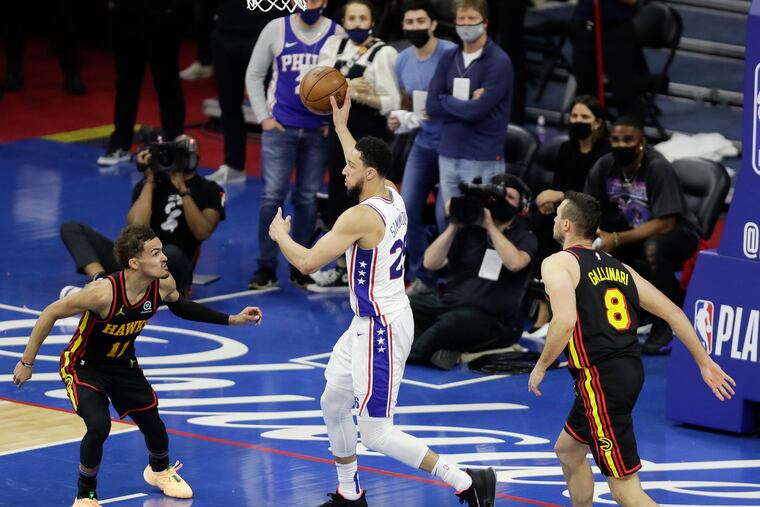Don’t fool yourselves. The Sixers miss Ben Simmons, in one area in particular | David Murphy
As good as Tyrese Maxey has been, the Sixers have missed Ben Simmons in one crucial aspect of the game. The numbers tell a dire tale.

It’s been said approximately 934 times, mostly because it’s true. The reason Ben Simmons is still getting a W-2 from the Sixers is that there are very few scenarios in which the Sixers are a better team with him off the books. That’s not a popular opinion, but then, few fact-based opinions are. What makes this one especially divisive is that its counterargument can also be true. The Sixers may not be a better team without Simmons, but they are not a championship team with him, and if the Sixers’ goal is to win a championship, which it is, then ... ipso facto, you know.
It’s a paradox, one that we are currently seeing play out as the Sixers muddle through a 16-15 start with significant declines in both their offensive and defensive ratings. Granted, Simmons’ absence has been easy to overlook. That’s mostly because the guy who is drawing the lion’s share of his minutes is turning out to be everything that Simmons’ detractors (read: everybody) blame him for not being.
Tyrese Maxey attacks off the dribble, pulls up from three-point range, goes and gets buckets, laughs, smiles, acts like he enjoys the challenge of getting better against the world’s best competition. Except, the Maxey thing is part of the paradox. He might be more fun to watch than the previous point guard, but the Sixers would be in a lot better shape if both players were on the court together.
» READ MORE: Tyrese Maxey emerged as COVID-19 ravaged the Sixers. Now he’s readjusting to life with Joel Embiid.
Nowhere has this reality been more evident than on the offensive and defensive glass. Forget about the box-score numbers. It’s true that individual rebounding numbers are a noisy statistic. The NBA’s current King of the Glass is Andre Drummond, who is leading the league with an average of 23.8 boards per 100 possessions. That might make for a fun page in Drummond’s scrapbook, but it tells us very little about Drummond’s contribution to the team. Likewise, Simmons’ first four seasons include all sorts of rebound-related factoids that sound good on a resumé but shouldn’t be mistaken for proof that he is a young Oscar Robertson. Still, Simmons’ holdout has given us a unique opportunity to run an A/B test on the Sixers, and the disparity between 2021-22 and the previous four seasons are rather telling.
From 2018-21, the Sixers ranked no worse than 10th in the NBA in offensive rebounding percentage and no worse than 11th in defensive rebounding percentage. Last year, they rebounded 23.2% of their own missed shots, and 78.2% of their opponents’. This year, those rates are 18.4% and 76.0%, which rank 30th and 24th out of 30 NBA teams.
One of the reasons Simmons’ impact is easy to overlook is that it is best measured through abstract stats like “rebounding percentage.” But think about what that number means. In a 100-possession game, Simmons will grab 2.7 offensive boards, per his career rate. This year, Maxey is averaging 0.6 offensive rebounds per 100 possessions. If the Sixers average 1.1 points per possession, and every offensive rebound results in a new possession, the difference is 2.2 points over the course of a 100-possession game. To put that in perspective, 2.2 point per 100 possessions is the difference between the Sixers scoring 109.3 points (20th in the NBA) and 111.5 points (fifth in the NBA). It’s half of the difference between their offensive rating this year and their offensive rating last year.
Keep in mind, that’s strictly the offensive rebounds that Simmons corrals. It does not factor in any rebounds that were partially attributable to his presence on the court. Joel Embiid has never finished a season averaging fewer than 3.4 offensive boards per 100 possessions. This season, he is averaging 2.4.
Furthermore, the offensive glass is only half of the game. Of equal value is the prevention of offensive rebounds on the defensive end, something that has plagued the Sixers all season. They’ve lost the offensive rebounding battle in 20 of their first 31 games this year, something that happened just 12 times in their first 31 of 2020-21. You can argue that the single most impactful difference between this year and last year lies in second-chance points. Last year, they scored an average of 13.9 per game, which ranked fifth in the league, and allowed an average of 11.6, which ranked fourth. This year, they are scoring 10.6 (26th) and allowing 14.4 (27). All told, that’s a net difference of 6.1 points per 100 possessions between this year and last year. Keep in mind, they outscored opponents by an average of 5.9 points per 100 possessions last year. This year, they are being outscored by 0.9. Think about that. Overall, they are 6.8 points worse per 100 possessions this year, and they are 6.1 points worse in second-chance points.
This is the paradox. So much of what Simmons contributes to regular-season success is easy to overlook because it does not involve him personally depositing the ball in the basket. Furthermore, the value of those contributions wanes once the playoffs start, given the nature of the postseason game. Yet there is value in winning regular-season games, and the size and awareness that Simmons’ brings to a perimeter slot has helped the Sixers win a lot of regular-season games.
Therein lies the shame of the current situation, something that has only been compounded by Maxey’s emergence. Simmons is forcing the Sixers to find a trade for a player who will improve their current lineup. But few players would improve it more than Simmons himself.